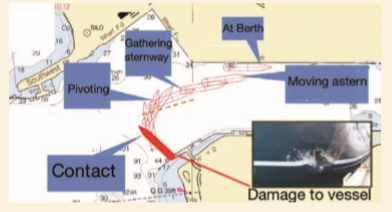202019 Less than adequate BRM allows single point failure
As edited from official NTSB (USA) Marine Accident Brief DCA19FM012
A passenger ship was leaving dock in darkness. The Master, a pilot and the OOW were on the bridge. A tug was secured aft on the starboard quarter. When the lines were clear and under the pilot’s instructions the tug pulled while the Master operated the bow thruster to move the vessel off the berth. Once the vessel was about 20 metres off the berth the pilot requested astern engine and stopped the tug.
A port swing was initiated in order to turn the ship 180°. The tug was initiated again to help with the turn and the Master used the bow thruster to port. The pilot then requested ahead propulsion, but the Master mistakenly set it to astern instead. The pilot could not see the controller the Master was using, nor the RPM or rudder angles. The Master, for his part, was operating the RPMs, rudder (one joystick) and bow thruster, and was not repeating the orders in a closed-loop manner. The OOW warned the Master, in a language that was not understood by the pilot, that the propulsion was astern, but the Master did not respond. Distances aft were being reported to the bridge by VHF radio, again in a language that was not understood by the pilot.
As the vessel gathered sternway, it contacted the dolphins aft. The investigation found, among other things, that the Master’s abilities were probably negatively affected by alcohol consumption.

Although the major contributing factor to this accident appears to be alcohol abuse by the Master, several other factors conspired to allow the mishap. Had proper BRM been applied, the single point failure of the Master may have been avoided.
Lessons learned
- The bridge team, including the pilot, should all be on the same page. To accomplish this a plan should be agreed and implemented and a common language used.
- Closed-loop communications are an essential part of good BRM.
